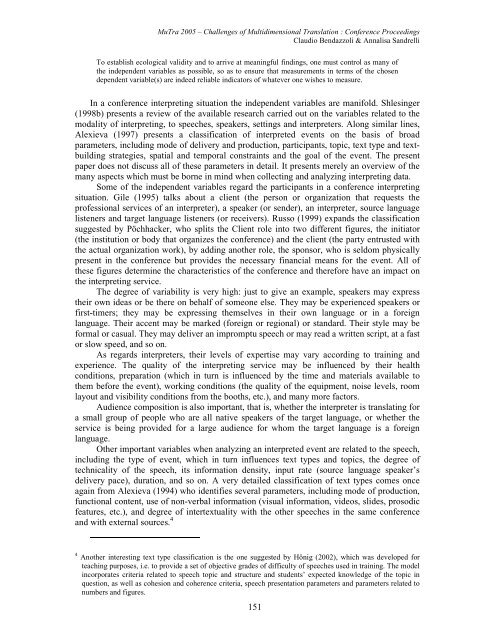Proceedings - Translation Concepts
Proceedings - Translation Concepts
Proceedings - Translation Concepts
Create successful ePaper yourself
Turn your PDF publications into a flip-book with our unique Google optimized e-Paper software.
MuTra 2005 – Challenges of Multidimensional <strong>Translation</strong> : Conference <strong>Proceedings</strong><br />
Claudio Bendazzoli & Annalisa Sandrelli<br />
To establish ecological validity and to arrive at meaningful findings, one must control as many of<br />
the independent variables as possible, so as to ensure that measurements in terms of the chosen<br />
dependent variable(s) are indeed reliable indicators of whatever one wishes to measure.<br />
In a conference interpreting situation the independent variables are manifold. Shlesinger<br />
(1998b) presents a review of the available research carried out on the variables related to the<br />
modality of interpreting, to speeches, speakers, settings and interpreters. Along similar lines,<br />
Alexieva (1997) presents a classification of interpreted events on the basis of broad<br />
parameters, including mode of delivery and production, participants, topic, text type and textbuilding<br />
strategies, spatial and temporal constraints and the goal of the event. The present<br />
paper does not discuss all of these parameters in detail. It presents merely an overview of the<br />
many aspects which must be borne in mind when collecting and analyzing interpreting data.<br />
Some of the independent variables regard the participants in a conference interpreting<br />
situation. Gile (1995) talks about a client (the person or organization that requests the<br />
professional services of an interpreter), a speaker (or sender), an interpreter, source language<br />
listeners and target language listeners (or receivers). Russo (1999) expands the classification<br />
suggested by Pöchhacker, who splits the Client role into two different figures, the initiator<br />
(the institution or body that organizes the conference) and the client (the party entrusted with<br />
the actual organization work), by adding another role, the sponsor, who is seldom physically<br />
present in the conference but provides the necessary financial means for the event. All of<br />
these figures determine the characteristics of the conference and therefore have an impact on<br />
the interpreting service.<br />
The degree of variability is very high: just to give an example, speakers may express<br />
their own ideas or be there on behalf of someone else. They may be experienced speakers or<br />
first-timers; they may be expressing themselves in their own language or in a foreign<br />
language. Their accent may be marked (foreign or regional) or standard. Their style may be<br />
formal or casual. They may deliver an impromptu speech or may read a written script, at a fast<br />
or slow speed, and so on.<br />
As regards interpreters, their levels of expertise may vary according to training and<br />
experience. The quality of the interpreting service may be influenced by their health<br />
conditions, preparation (which in turn is influenced by the time and materials available to<br />
them before the event), working conditions (the quality of the equipment, noise levels, room<br />
layout and visibility conditions from the booths, etc.), and many more factors.<br />
Audience composition is also important, that is, whether the interpreter is translating for<br />
a small group of people who are all native speakers of the target language, or whether the<br />
service is being provided for a large audience for whom the target language is a foreign<br />
language.<br />
Other important variables when analyzing an interpreted event are related to the speech,<br />
including the type of event, which in turn influences text types and topics, the degree of<br />
technicality of the speech, its information density, input rate (source language speaker’s<br />
delivery pace), duration, and so on. A very detailed classification of text types comes once<br />
again from Alexieva (1994) who identifies several parameters, including mode of production,<br />
functional content, use of non-verbal information (visual information, videos, slides, prosodic<br />
features, etc.), and degree of intertextuality with the other speeches in the same conference<br />
and with external sources. 4<br />
4 Another interesting text type classification is the one suggested by Hönig (2002), which was developed for<br />
teaching purposes, i.e. to provide a set of objective grades of difficulty of speeches used in training. The model<br />
incorporates criteria related to speech topic and structure and students’ expected knowledge of the topic in<br />
question, as well as cohesion and coherence criteria, speech presentation parameters and parameters related to<br />
numbers and figures.<br />
151
















